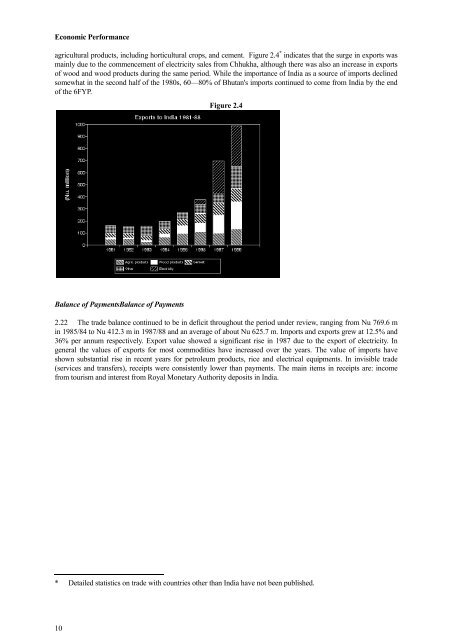- Page 1 and 2: COUNTRY BACKGROUND I. Physical Char
- Page 3 and 4: COUNTRY BACKGROUND Minerals The exa
- Page 5 and 6: COUNTRY BACKGROUND Bhutan is the le
- Page 7 and 8: COUNTRY BACKGROUND personnel polici
- Page 9 and 10: CHAPTER 2 ECONOMIC PERFORMANCEECONO
- Page 11 and 12: 2: Gross Domestic Product 1980 —
- Page 13 and 14: Figure 2.2 Economic Performance IV.
- Page 15 and 16: Table 2.4 Government Expenditures 1
- Page 17: Table 2.5 Summary of RGOB Budgetary
- Page 21 and 22: Economic Performance of Infant Mort
- Page 23 and 24: Approach to Development · sustaina
- Page 25 and 26: Approach to Development 3.19 The fo
- Page 27 and 28: Environment and Sustainable Develop
- Page 29 and 30: Environment and Sustainable Develop
- Page 31 and 32: Women's Involvement in Development
- Page 33 and 34: CHAPTER 6 PRIVATISATION AND PUBLIC
- Page 35 and 36: unacceptably high inequalities of i
- Page 37 and 38: CHAPTER 7 ECONOMIC OUTLOOKECONOMIC
- Page 39 and 40: Economic Outlook 7.9 This section e
- Page 41 and 42: Table 7.2 Seventh Plan Outlay and S
- Page 43 and 44: Figure 7.2 Figure 7.3 Capital Expen
- Page 45 and 46: Economic Outlook economic sector wi
- Page 47 and 48: Economic Outlook recurrent expendit
- Page 49 and 50: Financing GapFinancing Gap Table 7.
- Page 51 and 52: Fiscal and Monetary Policy Table 8.
- Page 53 and 54: Fiscal and Monetary Policy Strategy
- Page 55 and 56: Fiscal and Monetary Policy Table 8.
- Page 57 and 58: Fiscal and Monetary Policy TABLE 8.
- Page 59 and 60: I. IntroductionI. Introduction CHAP
- Page 61 and 62: Aid Policy 9.9 Sectoral Allocation
- Page 63 and 64: Aid Policy 9.20 Sector Ministries,
- Page 65 and 66: Aid Policy Aid and the Private Sect
- Page 67 and 68: Culture and Religion Dratshangs and
- Page 69 and 70:
Culture and Religion and documented
- Page 71 and 72:
Culture and Religion V. Financial a
- Page 73 and 74:
Education Table 11.1 Educational In
- Page 75 and 76:
Education Higher EducationHigher Ed
- Page 77 and 78:
Education 11.24 In 1986, the enrolm
- Page 79 and 80:
Education Table 11.3 Enrolment Targ
- Page 81 and 82:
Education particularly of the natio
- Page 83 and 84:
Education writing and numeracy and
- Page 85 and 86:
CHAPTER 12 Human Resource Developme
- Page 87 and 88:
of Bhutan + Corporation Planning Co
- Page 89 and 90:
Joint and Public Sector IndustriesJ
- Page 91 and 92:
Table 12.5 Sectoral Training Funded
- Page 93 and 94:
Human Resource Development IV. Manp
- Page 95 and 96:
CHAPTER 13 HEALTH SERVICESHEALTH SE
- Page 97 and 98:
Table 13.2 Health Institutions July
- Page 99 and 100:
A. Objectives and Strategies in the
- Page 101 and 102:
Table 13.5 Goals for Children and W
- Page 103 and 104:
Health Services IV. Health Sector P
- Page 105 and 106:
Mother and Child Health (MCH)Mother
- Page 107 and 108:
TOTALS FOR Health 1992/93 1993/94 1
- Page 109 and 110:
Human Settlements Chhukha. Certifie
- Page 111 and 112:
Human Settlements Lack of Skilled M
- Page 113 and 114:
Human Settlements only a fraction -
- Page 115 and 116:
Human Settlements awareness of the
- Page 117 and 118:
CHAPTER 15 TRANSPORT SECTORTRANSPOR
- Page 119 and 120:
Table 15.2 Passenger Carriage by Dr
- Page 121 and 122:
Civil AviationCivil Aviation Transp
- Page 123 and 124:
Transport Sector 15.25 In the 7FYP,
- Page 125 and 126:
Transport Sector target for formati
- Page 127 and 128:
Transport Sector 11
- Page 129 and 130:
CHAPTER 16 COMMUNICATIONS SECTORCOM
- Page 131 and 132:
Table 16.1 Telephone Facilities 199
- Page 133 and 134:
A. Objectives for the 7FYPA. Object
- Page 135 and 136:
Communications Sector Dzongkhags -D
- Page 137 and 138:
TOTALS FOR Department of Post, Tele
- Page 139 and 140:
Renewable Natural Resources Table 1
- Page 141 and 142:
Renewable Natural Resources earning
- Page 143 and 144:
Renewable Natural Resources 17.27 T
- Page 145 and 146:
Renewable Natural Resources Table 1
- Page 147 and 148:
Renewable Natural Resources coopera
- Page 149 and 150:
Renewable Natural Resources Institu
- Page 151 and 152:
Renewable Natural Resources 17.67 A
- Page 153 and 154:
Renewable Natural Resources Wildlif
- Page 155 and 156:
Renewable Natural Resources TOTALS
- Page 157 and 158:
Chapter 18 MANUFACTURING AND TRADEM
- Page 159 and 160:
18.8 (see Chapter 19 on Mineral Dev
- Page 161 and 162:
Input supplyInput supply Manufactur
- Page 163 and 164:
Manufacturing and Trade Polythene P
- Page 165 and 166:
Manufacturing and Trade Formulation
- Page 167 and 168:
Manufacturing and Trade V. Financia
- Page 169 and 170:
Mineral Development Coal mining and
- Page 171 and 172:
Mineral Development Table 19.2 Esti
- Page 173 and 174:
Mineral Development be purchased: 3
- Page 175 and 176:
CHAPTER 20 ENERGY SECTORENERGY SECT
- Page 177 and 178:
Exports and ImportsExports and Impo
- Page 179 and 180:
Energy Sector 20.21 Most of the rur
- Page 181 and 182:
shortages. Energy Sector 20.34 Alte
- Page 183:
Energy Sector items will include pu

















